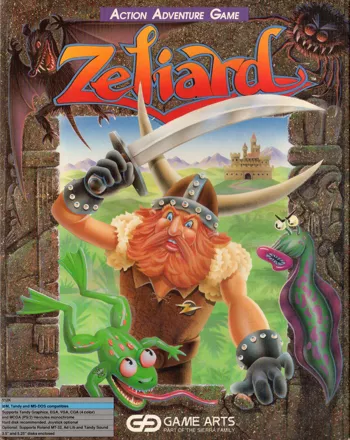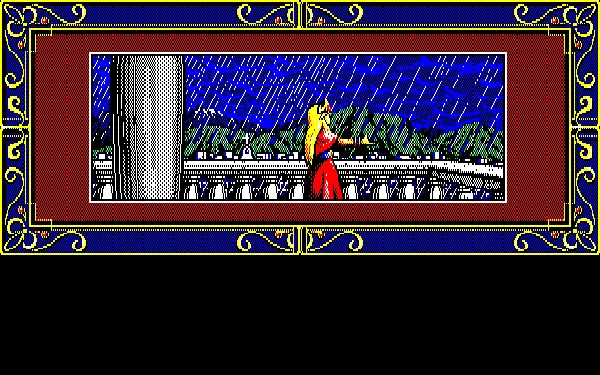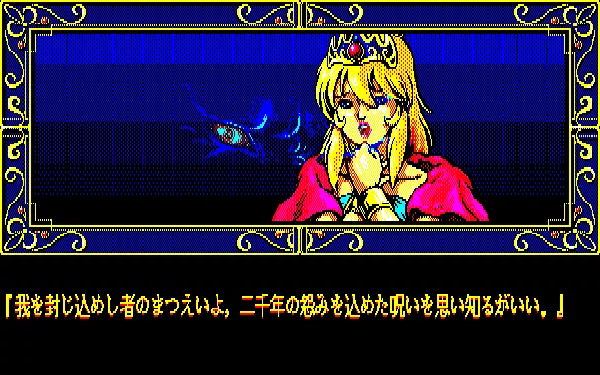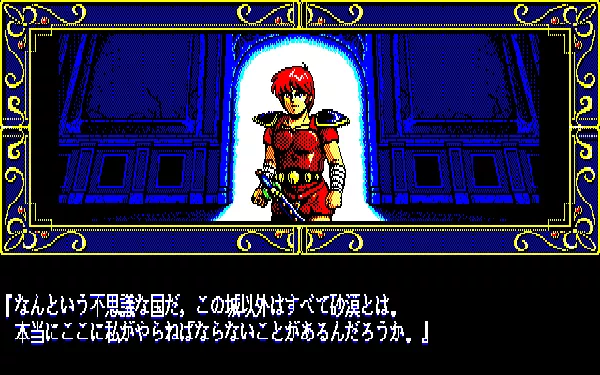Zeliard
Description official description
The ancient demon Jashiin has slept for two thousand years. When he awakens, he directs his wrath towards the kingdom of Zeliard, whose rulers of yore have allegedly harmed him. For 115 days, a sand rain devastates the kingdom, turning it into a desert. To complete his cruel revenge, Jashiin turns Felicia, the princess of Zeliard, into a stone. The valiant Duke Garland sets out on a quest to vanquish the demon and restore the princess to her true form. To do that, he must collect the Nine Tears of Esmesanti, which alone can reverse the terrible curse.
Zeliard is a side-scrolling action game with platforming and role-playing elements. The game world is divided into hostile labyrinths, which occupy its largest portion and contain maze-like passages for Duke Garland to traverse, as well as enemies that must be dealt with. Crests and keys must often be collected in order to ensure the progress to the next area. Garland takes damage from enemy attacks as well as the environment (hidden spikes, high temperature, etc.), but suffers no damage should he fall off a platform.
The hero uses his sword to combat the enemies, and shield to defend himself. He can also learn and cast projectile offensive magic. Special items can restore his health, increase the damage inflicted with the sword, grant additional protection, etc. Various types of clothes can be equipped; these can bestow the hero with further enhancements and immunities, such as prevent him from slipping on ice, allow him to jump higher, etc.
The Duke will visit different towns during his journey. In these towns, he can rest, replenishing his health, purchase and repair weapons and armor, acquire potions, and learn magic spells. Currency is obtained by exchanging enemy spirits for gold in banks. These spirits (called "almas") also serve as experience points: after the player has obtained a sufficient amount of them, the protagonist receives upgrades to his health and magic points from a local town sage.
Spellings
- ゼリアード - Japanese spelling
Screenshots
Credits (PC-88 version)
53 People · View all
| Programmer | |
| System Design |
|
| Adviser | |
| Sub Programmer | |
| Graphics Design | |
| Music Composer |
|
| DOS | |
| Story |
|
| Editor | |
| Illustration |
|
| Package Design | |
| Photograph | |
| Test Play | |
| Marketing Directer | |
| [ full credits ] | |
Reviews
Critics
Average score: 51% (based on 3 ratings)
Players
Average score: 3.8 out of 5 (based on 34 ratings with 3 reviews)
Get into Zeliard --- because you can
The Good
Zeliard was developed by Game Arts and published by Sierra On-Line. It was originally released in 1987 for the Sharp X1 and NEC PC-8801 computers, but due to the licensing agreements between Sierra and Game Arts, it saw a release in both North America and Europe in 1990 for MS-DOS computers.
In this game, the player controls Duke Garland, a knight who is called upon by King Felishika to recover the Nine Tears of Esmesanti that will lift the curse set onto his daughter by the ancient demon Jashiin, who also causes a sandstorm that has turned the Kingdom of Zeliard into desert. In addition to recovering the Nine tears, Garland must also defeat Jashiin and put him to sleep for another two-thousand years, to restore Zeliard to its former beauty. There is an excellent introduction you can watch before you start the game, which is well written and lasts for ten minutes.
The game reminds me a bit of Wonder Boy in Monster Land, a Master System game that I played years before this one. You enter towns and talk to people, purchase equipment (with golds), and do other tasks like saving your game, doing bank transactions, and resting for your journey ahead. However, the majority of the game takes place inside the caverns filled with Jashiin's minions. Deposing of them leaves behind a thing called almas, which can be exchanged for golds at the bank. There are keys needed to be collected, as well as any miscellaneous items that can help you survive the terrain. A boss needs to be defeated at the end of each cavern to get one of the Tears.
There are about nine caverns, and the first few caverns that you venture through are easy so that you become familiar with their layout. Later caverns become more difficult, with precise timing needed to get to certain platforms. In these caverns, if you mistime a jump, Garland may fall down a great distance, possibly with no hope of returning to that same spot. Enemies in the caverns get more and more difficult to defeat if you don't have the right equipment. I remember these blue dogs in the fire caverns pushing me off the platform I was on, and the only way I could deal with these dogs is to jump over them and kill them with whatever sword I was carrying. Even if you fall off a platform and return to the same platform, the same enemy will often respawn.
Aside from the introduction which also feature nice anime graphics, the graphics (in both the towns and the caverns) are impressive. Most of the towns have mountains that serve as the backdrop, while those located underground have stalactites, and both of these look really good. The status bar tells you how much life you have, your location, and the amount of golds and alma you have. Above the main action area is an indicator of the number of Tears you collected so far. This is very useful as it shows how many bosses you still need to defeat.
Mecano Associates did a wonderful job with the sound. As far as I know, Zeliard was one of the first games where you can use one sound device for music and another for sound effects. (I used the Roland MT-32 and Adlib, respectively). Some of the sound effects are amazing. Giving the player a warning that the boss is behind a locked door, and having the volume of it increasing or decreasing depending on how close you are, is a stroke of genius.
The control system is really simple to learn. You interact with characters, select menu items, and swing swords by pressing [Space] while you press [Alt] to use magic spells. Of course, you use the arrow keys to move your character left or right, and press the up arrow key to make a jump. Swinging your sword while pushing certain arrow keys or jumping causes Garland to swing his sword in all directions, which is most useful for digging through terrain or aiming for a head slash.
Zeliard is the type of game that deserves to be played again, due to the high amount of exploration within the caverns. There are many chests containing health and gold coins that the player might miss the first time, and the player might want to fight through the caverns using swords and magic potions. The more enemies you encounter if you decide to explore the caverns further, the more chance you get heaps of almas.
The Bad
Anytime during the game, you can change weapons, magic, and items if you want a change from using the same ones for quite some time, by pressing [Enter]. However, this becomes tedious because it takes a long time to select anything you want if there are more than ten items in your inventory, and you are likely to select the wrong thing.
In the PC-8801 version, the introduction had the sound of falling rain in the first scene, as well as other sounds such as Felicia's scream as she is turned to stone. This was left out of the MS-DOS version.
The Bottom Line
In conclusion, Zeliard is an impressive action adventure game from the makers of Thexder. You start off in towns, buying necessary equipment and other things, then you make your way towards the caverns, finding some way to reach the bosses who hold one of the Nine Tears of Esmesanti. Not only are the graphics great and the sound brilliantly composed, but the text is also in English instead of Japanese, there are more graphics mode, and more than one sound device can be used. All of these accomplishments mean that the MS-DOS version is superior.
DOS · by Katakis | カタキス (43086) · 2014
Nice action-oriented console gaming!
The Good
Well the musics are good and the game has an addictive quality.. for me anyway..
And I like the cutesy graphics too ^_^
The Bad
Some of the mazes are a bit too.. mazey. :)
The Bottom Line
A very consolish action platform game with an adventurey quality.
DOS · by RmM (68) · 1999
The Good
The story line was excellent. The cut scene's were state of the art at the time. The game came with a huge map which was more of a tease trying to figure out how to get to.
The Bad
Slightly hard to control some of the movement.
The Bottom Line
Excellent early platform game. And you can't go wrong with game arts.
DOS · by gametrader (208) · 2000
Trivia
Enhanced PC Speaker support
Zeliard had a unique PC Speaker support: It could play music with multiple channels. To activate this, you had to install the game with PC Speaker as the music device. When running the game, use the F1 key to toggle between the following modes: * Music On; Single Channel * Music Off * Music On; Multiple Channels * Music Off
Graphics
When using EGA the game's resolution is 640x200 instead of 320x200. However, MCGA mode uses 64 colors, whereas the EGA version simulates 64 colors by dithering.
Map
Included with the game was a large poster containing a map of each cavern. While not necessary for gameplay, later levels became quite difficult without it. The map is not quite complete, and omits invisible barriers and doesn't indicate where a door will lead.
Music & sound
A nice feature included (which was still somewhat uncommon at the time) is the ability to select different hardware for music and sound effects. Since sound effects are not supported for the Roland MT-32 (only music), this allows a Roland MT-32 to be used for music, and another supported sound device (such as Adlib or Tandy 3-voice) to be used for the sound effects providing an impressive soundtrack.
Programming
Zeliard was able to have a fairly large smoothly scrolling screen, even on slower computers. This was accomplished by breaking the screen up into a grid, and only redrawing sections that actually changed instead of having to redraw the entire screen for each frame. Sierra used this technique on several other Game Arts conversions, such as Firehawk.
Information also contributed by Servo
Analytics
Upgrade to MobyPro to view research rankings and price history! (when applicable)
Identifiers +
Contribute
Are you familiar with this game? Help document and preserve this entry in video game history! If your contribution is approved, you will earn points and be credited as a contributor.
Contributors to this Entry
Game added by Donny K..
PC-88 added by Terok Nor. Sharp X1 added by Unicorn Lynx.
Additional contributors: Omer Mor, Rik Hideto.
Game added August 9, 1999. Last modified February 14, 2025.







